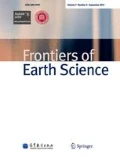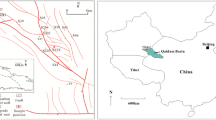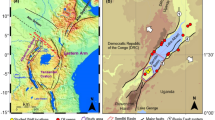Abstract
The Middle Cretaceous Mishrif Formation of the Cenomanian-Turonian age is an important Middle Eastern reservoir. Previous studies have shown that carbonates in the Mishrif Formation are affected by karstification and are concentrated at the top of the formation. However, there is a lack of systematic research on the effects of karstification on the formation’s reservoir characteristics. Based on core samples, scanning electron microscopy of thin sections, and geochemical analysis of C, O, and Sr isotopes from wells in the Missan Oil Fields, unconformity was identified at the top of the B21 subzone of the Mishrif Formation. Core and cast-thin-section observations indicate that there is a significant lithological difference above and below the unconformity, and dissolution pores and voids are well-developed beneath it. Vadose silt fills the intragranular pores and geopetal fabric is developed inside some mouldic pores beneath the unconformity surface. The isotopic values of 87Sr/86Sr (0.707270–0.707722) and δ18O (− 5.94 ‰— −2.32 ‰) suggest that the top of the B21 subzone of the Mishrif Formation has been severely affected by syngenetic karst. Karstification is the key to high-quality reservoir formation and the reservoir’s oil-bearing heterogeneity. This study will inform oil and gas exploration in the Missan Oil Fields and in other areas with similar reservoir characteristics.
Similar content being viewed by others
References
Al-Ekabi A H S (2015). Microfacies and environmental study of the Mishrif Formation in Noor field. Arab J Geosci, 8(8): 5779–5794
Alsharhan A S, Nairn A E M (2003). Sedimentary Basins and Petroleum Geology of the Middle East. Amsterdam: Elservier
Aqrawi A A M, Thehni G A, Sherwani G H, Kareem B M A (1998). Mid-Cretaceous rudist-bearing carbonates of the Mishrif Formation: an important reservoir sequence in the Mesopotamian basin, Iraq. J Pet Geol, 21(1): 57–82
Assadi A, Honarmand J, Moallemi S A, Abdollahie-Fard I (2018). An integrated approach for identification and characterization of palaeo-exposure surfaces in the upper Sarvak formation of Abadan plain, SW Iran. J Afr Earth Sci, 145: 32–48
Baceta J I, Wright V P, Beavington-Penney S J, Pujalte V (2007). Palaeohydrogeological control of palaeokarst macro-porosity genesis during a major sea-level lowstand: Danian of the Urbasa-Andia plateau, Navarra, North Spain. Sediment Geol, 199(3–4): 141–169
Burchette T P (1993). Mishrif Formation (Cenomanian-Turonian), southern Arabian Gulf: carbonate platform growth along a cratonic basin margin. In: Simo J A, Scott RW, Masse J-P, eds., Cretaceous Carbonate Platforms. AAPG Memoir. 56: 185–199
Cazarin C L, Bezerra F H R, Borghi L, Santos R V, Favoreto J, Brod J A, Auler A S, Srivastava N K (2019). The conduit-seal system of hypogene karst in neoproterozoic carbonates in northeastern Brazil. Mar Pet Geol, 101: 90–107
Chen P Y, Tan X C, Yang H T, Tang M, Jiang Y W, Jin X J, Yu Y (2015). Characteristics and genesis of the Feixianguan Formation oolitic shoal reservoir, Puguang gas field, Sichuan Basin, China. Front Earth Sci, 9(1): 26–39
Chen P Y (2019). Characteristics of micro-fractures in carbonate reservoir of Mishrif Formation, B Oilfield of Iraq. Journal of Northeast Petroleum University, 43(6): 62–72 (in Chinese)
Choquette P W, James N P (1988). Palaeokarst. New York: Springer
Farzadi P (2006). The development of Middle Cretaceous carbonate platforms, Persian Gulf, Iran: constraints from seismic stratigraphy, well and biostratigraphy. Petrol Geosci, 12(1): 59–68
Fu Q, Qing H, Bergman C M (2006). Paleokarst in Middle Devonian Winnipegosis mud mounds, subsurface of south-central Saskatchewan, Canada. Bull Can Pet Geol, 54(1): 22–36
Gao J X, Tian C B, Zhang W M, Song X M, Liu B (2013). Characteristics and genesis of carbonate reservoir of the Mishrif Formation in the Rumaila oil field, Iraq. Acta Petrol Sin, 34(10): 843–852
Hajikazemi E, Al-Aasm I S, Coniglio M (2010). Subaerial exposure and meteoric diagenesis of the cenomanian-turonian upper Sarvak Formation, southwestern Iran. Geol Soc Lond Spec Publ, 330(1): 253–272
Hajikazemi E, Al-Aasm I S, Coniglio M (2012). Chemo stratigraphy of Cenomanian-Turonian carbonates of the Sarvak Formation, southern Iran. J Pet Geol, 35(2): 187–205
Haq B U, Al-Qahtani A M (2005). Phanerozoic cycles of sea-level change on the Arabian Platform. GeoArabia, 10(2): 127–160
Hollis C (2011). Diagenetic controls on reservoir properties of carbonate successions within the Albian-Turonian of the Arabian Plate. Petrol Geosci, 17(3): 223–241
Hopkins J C (1999). Characterization of reservoir lithologies within sub-unconformity pools: Pekisko Formation, Medicine River Field, Alberta, Canada. AAPG Bull, 83: 1855–1870
James N P, Choquette P W (1988). Paleokarst. New York: Springer-Verlag
Jia L Q, Cai C F, Jiang L, Zhang K, Li H X, Zhang W (2016). Petrological and geochemical constraints on diagenesis and deep burial dissolution of the Ordovician carbonate reservoirs in the Tazhong area, Tarim Basin, NW China. Mar Pet Geol, 78: 271–290
Jin M D, Zeng W, Tan X C, Li L, Li Z Y, Luo B, Zhang J L, Liu J W (2014). Characteristics and controlling factors of beach-controlled karst reservoirs in Cambrian Longwangmiao Formation, Moxi-Gaoshiti area, Sichuan Basin, NW China. Pet Explor Dev, 41(6): 712–723
Jolley S J, Fisher Q J, Ainworth R B (2010). Reservoir compartmentalization: an introduction. In: Jolley S J, Fisher Q J, Ainworth R B, Vrolijk P J, Delisle S, eds., Reservoir Compartmentalization, 347. Geological Society, 362: 1–8
Liu H, Tan X C, Li L, Ding X, Cao J, Yang G, Ma T (2019). Eogenetic karst in interbedded carbonates and evaporites and its impact on hydrocarbon reservoir: a new case from Middle Triassic Leikoupo Formation in Sichuan Basin, southwest China. J Earth Sci, 30(5): 908–923
Liu H Y, Tian Z Y, Liu B, Guo R, Yang D, Deng Y, Yu Y C, Shi K B (2018). Pore types, origins and control on reservoir heterogeneity of carbonate rocks in Middle Cretaceous Mishrif Formation of the west Qurna Oilfield, Iraq. J Petrol Sci Eng, 171: 1338–1349
Lousk R (1999). Paleocave carbonate reservoirs; origins, burial-depth modifications, spatial complexity, and reservoir implications. AAPG Bull, 83: 1795–1834
Luo B, Tan X C, Li L, Liu H, Xia J W, Du B Q, Liu X G, Mou X H (2010). Discovery and geologic significance of paleokarst unconformity between Changxing Formation and Feixianguan Formation in Shunan area of Sichuan Basin. Acta Petrol Sin, 31: 408–414
Machel H G, Lonnee J (2002). Hydrothermal dolomite-a product of poor definition and imagination. Sediment Geol, 152(3–4): 163–171
Mahdi T A, Aqrawi A A M, Horbury A D, Sherwani G H (2013). Sedimentological characterization of the mid-Cretaceous Mishrif reservoir in southern Mesopotamian Basin, Iraq. GeoArabia, 18: 139–174
Mahdi T A, Aqrawi A A M (2014). Sequence stratigraphic analysis of the mid-cretaceous Mishrif formation, southern mesopotamian basin, Iraq. J Pet Geol, 37(3): 287–312
de Periere M D, Durlet C, Vennin E, Caline B, Boichard R, Meyer A (2017). Influence of a major exposure surface on the development of microporous micritic limestones-example of the upper Mishrif Formation (Cenomanian) of the Middle East. Sediment Geol, 353: 96–113
Mehmandosti E A, Adabi M H, Woods A D (2013). Microfacies and geochemistry of the Middle Cretaceous Sarvak Formation in Zagros Basin, Izeh Zone, SW Iran. Sediment Geol, 293: 9–20
Moore C H, Wade W J (2013). Carbonate reservoirs: porosity and diagenesis in a sequence stratigraphic framework. Developments in Sedimentology, Elsevier.
Palmer M R, Edmond J M (1989). The strontium isotope budget of the modern ocean. Earth Planet Sci Lett, 92(1): 11–26
Pitman J K, Steinhour D, Lewan M D (2004). Petroleum generation and migration in the Mesopotamian Basin and Zagros Fold Belt in Iraq: results from a basin-modeling study. GeoArabia, 9(4): 41–72
Qiang Z T (1998). Geology of Carbonate Reservoir. China: Beijing, University of Petroleum Press (in Chinese).
Rahimpour-Bonab H, Mehrabi H, Navidtalab A, Omidvar M, Enayati-Bidgoli A, Sonei R, Sajjadi F, Amiri-Bakhtyar H, Arzani N, Izadi-Mazidi E (2013). Palaeoexposure surfaces in cenomanianesantonian carbonate reservoirs in the dezful embayment, SW Iran. J Pet Geol, 36(4): 335–362
Rahimpour-Bonab H, Mehrabi H, Enayati-Bidgoli A H, Omidvar M (2012). Coupled imprints of tropical climate and recurring emergence on reservoir evolution of a mid Cretaceous carbonate ramp, Zagros Basin, southwest Iran. Cretac Res, 37: 15–34
Roberts J, Turchyn A V, Wignall P B, Newton R J, Vane C H (2018). Disentangling diagenesis from the rock record: an example from the Permo-Triassic Wordie Creek Formation, East Greenland. Geochem Geophys Geosyst, 19(1): 99–113
Sadooni F N (2005). The nature and origin of upper cretaceous basin-margin rudist buildups of the mesopotamian basin, Southern Iraq, with consideration of possible hydrocarbon stratigraphic entrapment. Cretac Res, 26(2): 213–224
Scholle P A, Ulmer-Scholle D S A (2003). A color guide to the petrography of carbonate rocks: grains, textures, porosity, diagenesis. AAPG Mem, 77
Taylor A S, Lasaga A C (1999). The role of basalt weathering in the Sr isotope budget of the oceans. Chem Geol, 161(1–3): 199–214
Veizer J, Ala D, Azmy K, Bruckschen P, Buhl D, Bruhn F, Carden G A F, Diener A, Ebneth S, Godderis Y, Jasper T, Korte C, Pawellek F, Podlaha O G, Strauss H (1999). 87Sr/86Sr, δ13C and δ18O evolution of Phanerozoic seawater. Chem Geol, 161(1–3): 59–88
Vincent B, Van Buchem F S P, Bulot L G, Jalali M, Swennen R, Hosseini A S, Baghbani D (2015). Depositional sequences, diagenesis and structural control of the Albian to Turonian carbonate platform systems in coastal Fars (SW Iran). Mar Pet Geol, 63: 46–67
Wang J, Guo R, Zhao L M, Li W K, Zhou W, Duan T X (2016). Geological features of grain bank reservoirs and the main controlling factors: a case study on Cretaceous Mishrif Formation, Halfaya oilfield, Iraq. Pet Explor Dev, 43(3): 404–415
Xiao D, Tan X, Xi A, Liu H, Shan S, Xia J, Cheng Y, Lian C (2016). An inland facies-controlled eogenetic karst of the carbonate reservoir in the Middle Permian Maokou Formation, southern Sichuan Basin, SW China. Mar Pet Geol, 72: 218–233
Xiao D (2017). Research on eogenetic karst of marine carbonate and its reservoir in the three major basins western China. Dissertation for Doctoral Degree. Chengdu: Southwest Petroleum University
Xiao D, Zhang B J, Tan X C, Liu H, Xie J R, Wang L C, Yang X, Ma T (2018). Discovery of a shoal-controlled karst dolomite reservoir in the Middle Permian Qixia Formation, northwestern Sichuan Basin, Southwest China. Energy Exploration & Exploitation, 36(4): 686–704 (in Chinese)
Xiao D, Tan X C, Zhang D F, He W, Li L, Shi Y H, Chen J P, Cao J (2019a). Discovery of syngenetic and eogenetic karsts in the Middle Ordovician gypsumbearing dolomites of the eastern Ordos Basin (central China) and their heterogeneous impact on reservoir quality. Mar Pet Geol, 99: 190–207
Xiao D, Tan X C, Fan L Y, Zhang D F, Nie W C, Niu T, Cao J (2019b). Reconstructing large-scale karst paleogeomorphology at the top of the Ordovician in the Ordos Basin, China: control on natural gas accumulation and paleogeographic implications. Energy Sci Eng, 7(6): 3234–3254
Xiong Y, Tan X C, Zuo Z F, Zou G L, Liu M J, Liu Y, Liu L, Xiao D, Zhang J (2019). Middle Ordovician multi-stage penecontemporaneous karstification in north China: implications for reservoir genesis and sea level fluctuations, 183: 1–14
Yu Y C, Sun L D, Song X M, Guo R, Gao X J, Lin M J, Yi L P, Han H Y, Li F F, Liu H Y (2018). Sedimentary diagenesis of rudist shoal and its control on reservoirs: a case study of Cretaceous Mishrif Formation, H Oilfield, Iraq. Pet Explor Dev, 45(6): 1075–1087
Zhong Y, Tan X C, Zhao L M, Guo R, Li F, Jin Z M, Chen Y T, Xiao D (2019). Identification of facies-controlled eogenetic karstification in the Upper Cretaceous of the Halfaya oilfield and its impact on reservoir capacity. Geol J, 54(1): 450–465
Acknowledgements
We thank anonymous reviewers for detailed and constructive feedback that helped improve the manuscript. This work was supported by the Chinese “13th Five-year Plan” National Science and Technology Major Project (No. 2017ZX05032004-001).
Author information
Authors and Affiliations
Corresponding author
Rights and permissions
About this article
Cite this article
Chen, P., Guo, L., Li, C. et al. Karstification characteristics of the Cenomanian-Turonian Mishrif Formation in the Missan Oil Fields, southeastern Iraq, and their effects on reservoirs. Front. Earth Sci. 16, 435–445 (2022). https://doi.org/10.1007/s11707-020-0864-7
Received:
Accepted:
Published:
Issue Date:
DOI: https://doi.org/10.1007/s11707-020-0864-7




